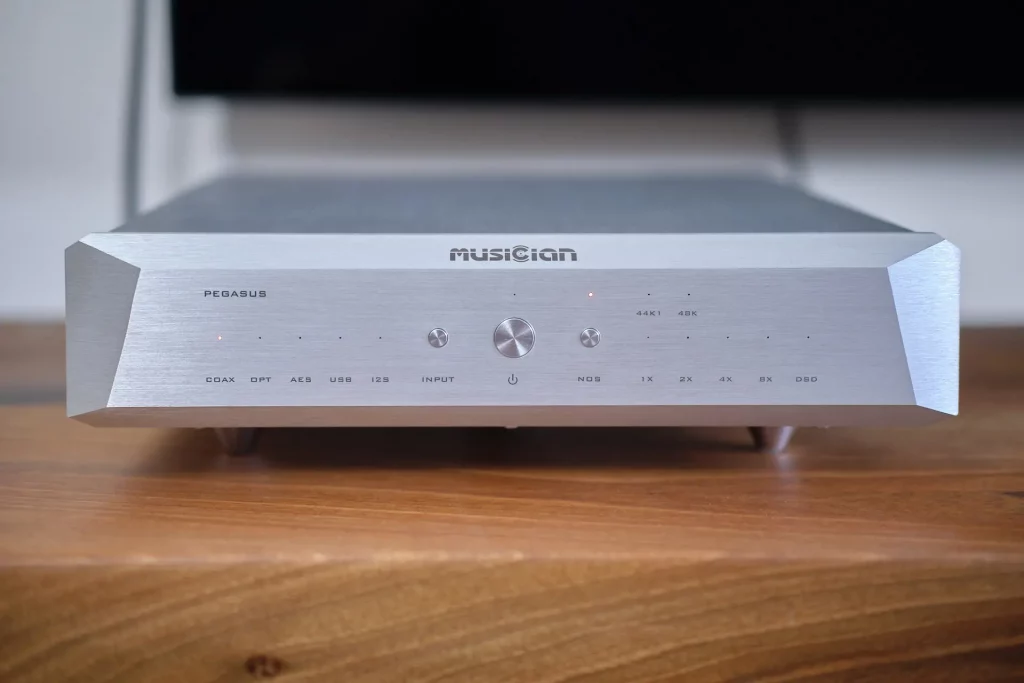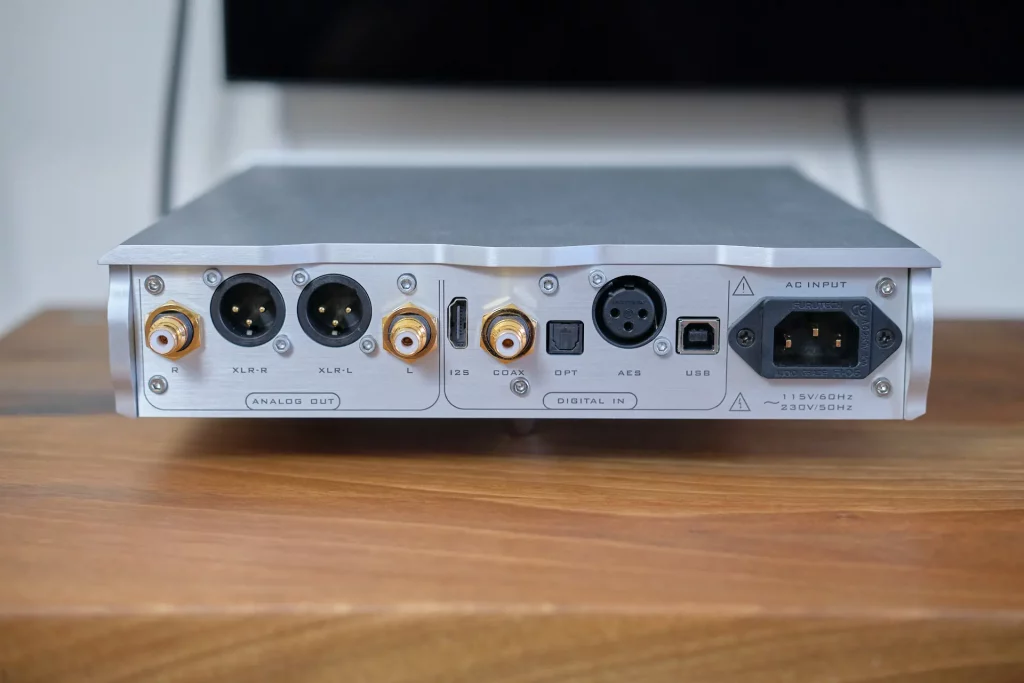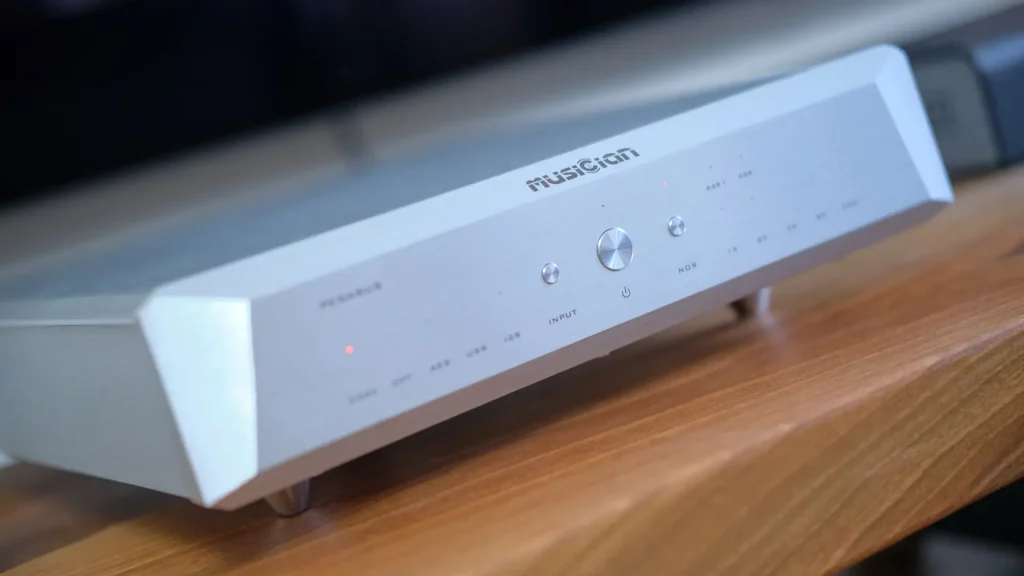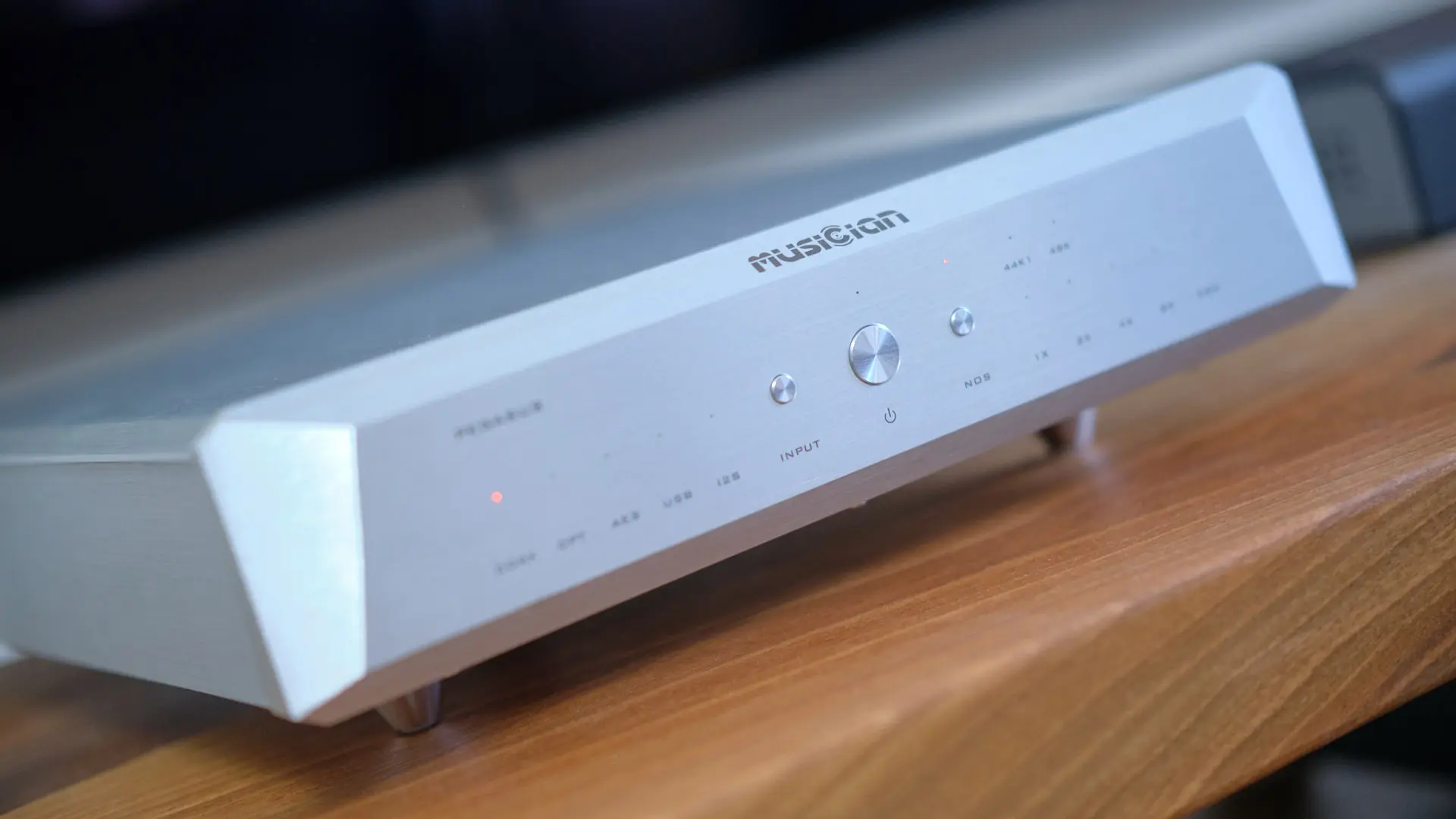Musician Audio is a relatively new brand in the HiFi market, and today we’re going to talk about their midrange DAC model named Pegasus. At first glance, Pegasus ticks all the right boxes and attracts my attention. It looks like a premium-built R2R DAC but comes with true attention to detail at a price that’s still attainable for many audiophiles. That said, eleven hundred dollars is not peanut money either so let’s see if this DAC has what it takes to be considered a good buy.
Build and Features
As soon as I took Musician Pegasus out of the box I was impressed by the sheer quality of its build. Thick aluminium plates cover all sides making this a hefty and sturdy-looking DAC. My particular unit comes in a natural silver aluminium finish with a brushed look, and I love its aesthetics. The front panel is simple with only a few buttons and several red LED indicators. But it’s not only about the looks because on the back we find connectors of really good quality, including the gilded IEC power socket sourced from a famed brand Furutech. I’ll leave the importance of this to the readers, but in my experience, the quality of connectors and parts used does matter when it comes to the final sonic result of a HiFi product.


Opening the unit reveals a big toroidal transformer that’s part of a linear power supply. If you’re a HiFi enthusiast, you’re probably already familiar with how clean and stable power influences the sound fidelity of any audio product. I won’t get into more construction details since that’s not the focus of any of my reviews, but it’s hard not to notice the attention to detail that Musician has put into this model. The cherry on top would probably be using 0.005% high-precision resistors in the R2R D/A conversion network, which is something that the competition simply doesn’t offer at this price point.
Pegasus is using FPGA to handle digital signal processing and provide support for up to PCM1536 and DSD1024 on USB and I2S inputs. The rest of the inputs, meaning coaxial SPDIF, optical TOSLINK, and AES/EBU will top at PCM192 and DSD64 (DoP) which is still plenty for most real-life usage scenarios. After signal processing, true balanced 24BIT R2R + 6BIT DSD (32 steps FIR Filters) is used to convert the digital signal into an analog one, and output it to either single-ended RCAs or balanced XLR connectors in the back.
For all its impressive specs and build quality, Pegasus is as spartan when it comes to the additional goodies as it gets. There is no remote control, nor any type of volume attenuation that would enable you to use it as a preamp too. What you can do is choose between oversampling (OS) and non-oversampling (NOS) modes of operation. But more on this in the sound section.
OS and NOS modes
So let’s start with that OS/NOS mode choice. I’ll just say that the difference between the two is not as prominent as I’ve noticed it to be with some other R2R models. NOS will provide a slightly softer, warmer, but hazier sound. Engaging the OS will clear things out and bring the overall clarity and tone separation closer to what a good Delta Sigma DACs can do. At first, I preferred NOS slightly, as OS was just a bit too thin for my taste. But after several weeks of burn-in, I felt that OS sound filled in, so I welcomed additional clarity of edges and transients that that mode brings, without introducing any negatives I can hear. So it ended with me using OS mode, but you might feel differently depending on your taste and the rest of your system, so try both for yourself and then retry it after putting several hundreds of working hours into the DAC.
Sound
It really didn’t take much time to appreciate what Musician Pegasus brought to the sound when connected to my main stereo setup. As you would expect from a good R2R DAC, Pegasus sounds very spacious. The soundstage is wide and deep and filled with neatly arranged musicians and singers. Those are again very skillfully placed inside of that soundstage and well separated from each other. But these are the traits that any good resistor ladder DAC can do very well, so let’s move to the ones that could be more troublesome like clarity, clean edges, and quick transients. Well, I’m happy to inform you that Pegasus does all of these and does them with flying colors, but let’s start from the bottom. The bassline is equally weighty and punchy, with plenty of kick when it is required. It’s not the most nimble bassline you’ll ever encounter but it’s also not slow by any stretch of the imagination. This kind of bold bass performance really creates a healthy tone core and lends authority to the whole sound. Moving to the midrange, we’re talking about a very revealing and clear presentation. Edges of tones are carved out with precision, and inner tone texture is readily revealed. But this is not some kind of analytical, details-first, type of sound because good tone density and rich tone timbre are present and accounted for. Well-extended highs come as a cherry on top, adding a breadth of air to all tones. All of these qualities mixed together result in a very natural, spacious, and effortlessly revealing sound signature.
As I mentioned above, this is not a slow or sluggish-sounding DAC. When a fast-paced song is put on, it will follow the rhythm without any trouble. Now add dynamic and lively delivery to the mix, and you quickly get a foot-tapping experience. If it seems like there are only positive but no negative impressions about the sound of this DAC, it’s only because that’s true. No matter what kind of music I tried, and how my mood and taste fluctuated during the testing process, I simply couldn’t catch Pegasus doing anything wrong. There is no overly soft, hazy, and bloomy sound that some lesser R2R designs can exhibit. You won’t find a slow and bloated bassline here, or any sort of artificially added grain in the midrange, etc. No, Musician Pegasus is simply a mighty good-sounding DAC without any obvious sonic flaw, and its limits can only be observed through a direct comparison with pricier models.

Comparisons
I’ll keep this part simple. First, I’m going to take the best-sounding and very popular R2R DAC up to this price that I’ve personally heard, then the best-sounding Delta Sigma DAC, and finally something pricier that can put Pegasus performance into a good perspective.
Denafrips Ares II is now a famous R2R model that I’ve personally used as my daily driver for a year and a half. This one has great tone timbre, fullness, natural music flow, and smoothness. But when directly put up against Musician Pegasus, it sounds unresolving and hazy. Ares II swallows fine details and glosses over quick transients to the point that it can almost sound muddy in a direct comparison with Pegasus. In the past, I accepted all of that as a necessity of an R2R design and paid that price to have a big and airy soundstage, lush tonality, rich vocals, and great tone texture. Ares II has all of that, but so does Pegasus. The trick is that Pegasus is also performing strongly in all the areas that Ares II is struggling with like having strong dynamics, quick transient response, and respectable clarity. Musician’s champion is more pricy but taking its superior sound as well as its richer connectivity into account, I feel that the price hike is more than justified.
Topping D90LE is basically a D90SE model without the MQA support. This one is as good of a Delta Sigma DAC as a thousand dollars can buy you these days. It’s characterized by a very quick, clean, and crisp sound. Edges are super clean and clearly outlined, while transients are as fast as it gets. The bassline is firm and grippy, and even the soundstage is more than adequate. In a direct comparison, Pegasus sounds more spacious, especially when it comes to the depth of the soundstage, and fills that soundstage with more air. The bassline is slightly weightier with Pegasus and slightly quicker but leaner with D90LE. Detail retrieval is comparable, but Pegasus presents those details with some kind of natural ease and tone flow that Topping can’t match, but keeps sounding tenser and more congested. So if we’re talking about the sonics, I find Pegasus to be a clear winner here. Topping D90LE is still quite good on its own, costs less, and offers more features, so there’s that.
Ladder Schumann is another spartan R2R DAC, without any additional features except just being a D/A converter. It’s both a newer and pricier model at $1400. All that said, Schumann is sonically doing everything Pegasus does but in a slightly fuller and more three-dimensional manner. The soundstage feels just a touch wider and deeper – not in the sense that it goes deeper behind your speakers, but more that it has better “front to back stretch”. This combined with a slightly fuller midrange creates more palpable vocals and instruments that feel more believably brought to life. It’s nothing you would miss on Pegasus in isolation really, but it can be observed in a direct comparison. This said, having in mind the price difference and the exact same feature sets, I feel that both these DACs are equally good choices.
Conclusion
Musician Pegasus is an astonishingly well-built and in my personal opinion equally beautiful device. But that would mean little if its sonic qualities are not up to the task. Fortunately, Pegasus is not only the best R2R DAC that I’ve heard up to 1100 dollars, but it is the best sounding DAC up to that price no matter the conversion technology used. If you want to better it you simply have to look at pricier models, and that’s as good of a recommendation for a product as any that I can give.
| MUSICIAN PEGASUS – CHARACTERISTICS |
|
Product type: DAC R2R |






Hi Mr Stojanovic,
That is an excellent review of the Pegasus. I had the Earmen Tradutto as well that you also wrote a good review on, but really wanted the great sound stage that the R2R style offers., so I upgraded. The Pegasus works great and presents the sound just right! I use Hifiman HE1000 Stealth headphones and they sound great with this DAC.
I brought it over to my friends house , he has a Schiit Gungnir. He A-B both DAC’s and found the sound quality almost identical, a good compliment to the Pegasus.
Thanks again for your great reviews,
Robert
I’m glad to hear you like it too. Enjoy.
Hello from France ,
Thanks for the articles and videos.
I currently have a “V-DAC musical fidelity” DAC and I would like to greatly improve the sound of my Klipsch RB81s.
I’m hesitating with 2 DACs that I can buy second-hand and which I’ve read good things about on your site and YouTube channel: – the musician pegasus DAC R2R (2021): €920 (seems a little expensive for the age…???): your rating: 9.1
– gustard R26 (2022) €900 (with a slight scratch and a dot on the glass and screen) your rating: 9.9
I like the musician pegasus with its absence of screen (to avoid the risk of screen wear), but what interests me most is the sound.
What choice do you recommend to make the most of my speakers?
Thank you